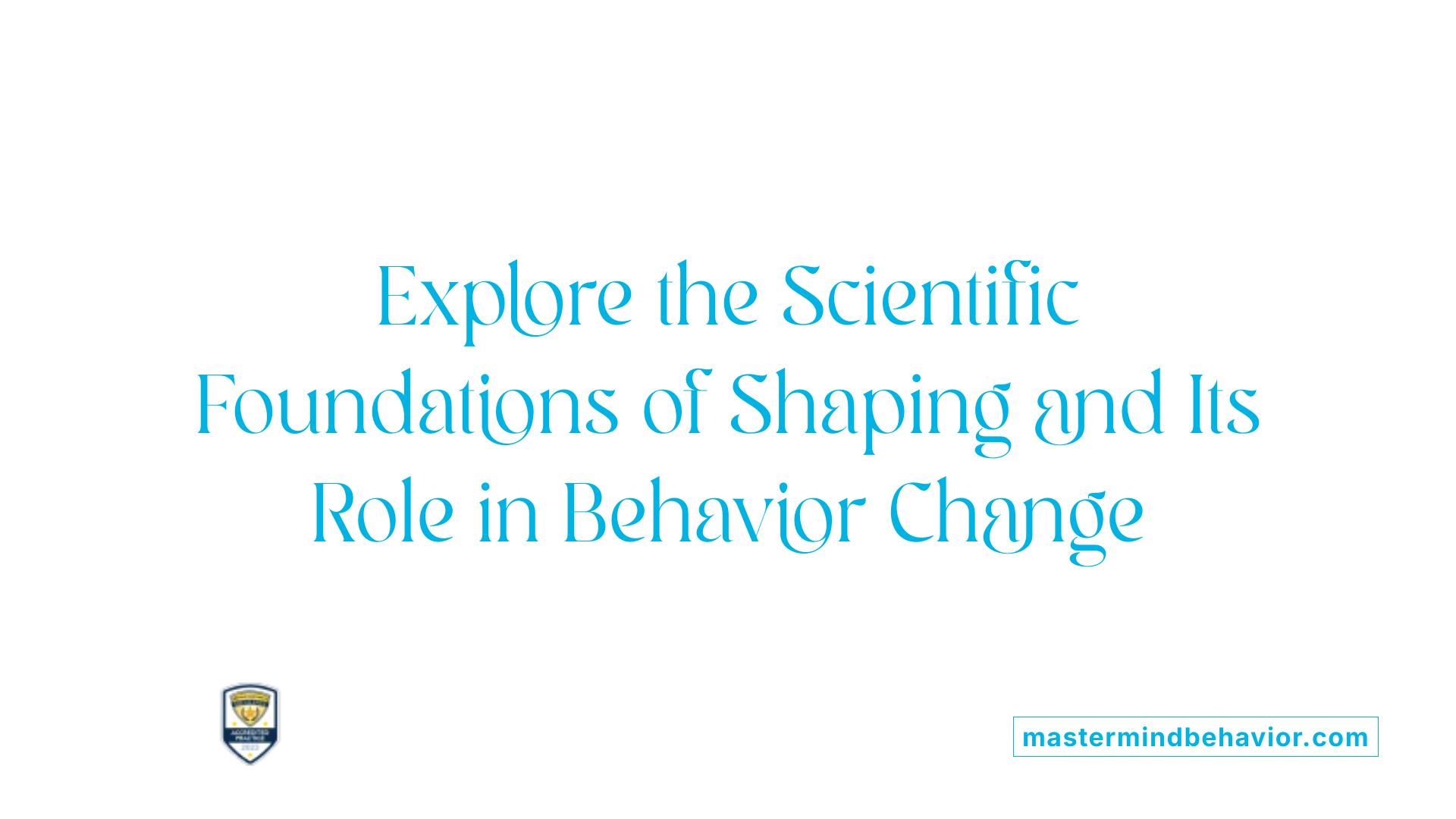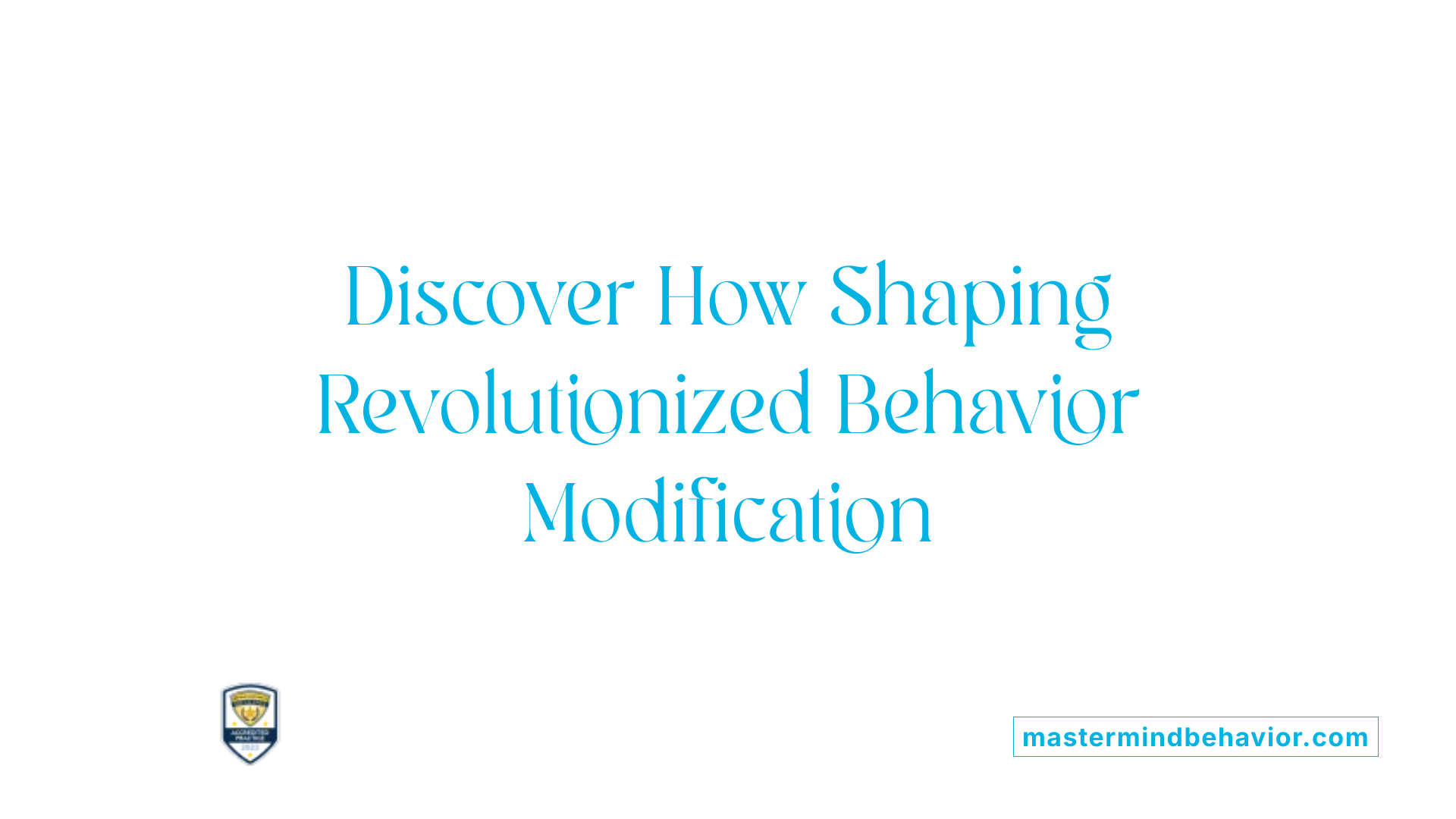Understanding the Role of Shaping in Behavior Modification
Behavior modification relies heavily on strategic methods to teach new skills, change undesirable behaviors, and establish positive habits. Among these techniques, shaping stands out as a fundamental approach rooted in operant conditioning principles. Its importance lies in its ability to facilitate incremental learning and behavioral change, especially for complex behaviors that are difficult to acquire through straightforward instruction or imitation.
Foundation and Principles of Shaping

What are the key principles and scientific foundations of shaping?
Shaping is rooted in the principles of operant conditioning, a learning process discovered by psychologist B.F. Skinner. The fundamental idea behind shaping is that complex behaviors can be learned through reinforcement of smaller, successive steps that gradually resemble the final desired behavior.
The process begins with task analysis, breaking down the target behavior into manageable, smaller components. Each of these steps is reinforced when performed, especially behaviors that are closer to the goal. For example, if the goal is to teach a child to sit for five minutes, initial reinforcement might be given for simply sitting down, then for sitting longer, and eventually for maintaining the sitting position.
A core component of shaping is differential reinforcement. This involves reinforcing behaviors that are increasingly close to the target while withholding reinforcement for behaviors that are less accurate. This selective reinforcement encourages the individual to progress along a learning curve, gradually approximating the desired behavior.
The scientific foundation of shaping goes beyond anecdotal evidence. Experimental research across many species, including humans, has demonstrated its effectiveness. Behavioral theories support that reinforcement of successive approximations systematically builds new skills. Moreover, computational models like the modified McDowell model simulate the dynamics of shaping, suggesting that continuously narrowing the reinforcement window enhances learning efficiency by focusing on behaviors closer and closer to the target.
Overall, shaping's principles rely on incremental learning, reinforcement strategies, and task analysis, all grounded in a solid scientific framework that emphasizes observable behavior changes.
How is shaping used in designing behavior change programs?
Shaping plays a vital role in developing behavior change programs by providing a structured approach to teach new skills or modify existing behaviors. The core method involves analyzing a complex behavior into small, achievable steps. Once these steps are identified, the program reinforces correct behaviors along the way, gradually increasing the difficulty or sophistication of the task.
For instance, in health interventions aimed at increasing physical activity, shaping might start by reinforcing the individual for engaging in any movement. Over time, the criteria might be adjusted so that longer durations of activity are reinforced, moving toward the ultimate goal of sustained exercise.
This approach makes behavior change adaptable and manageable, especially when tackling behaviors that are initially difficult to learn via traditional instruction or imitation. It allows for personalized pacing, reinforcing the individual's progress and confidence.
Modern behavior change strategies incorporate advanced tools like JITAI—Just-In-Time Adaptive Interventions—that apply shaping principles in real-time. These interventions utilize sensors and algorithms to constantly assess behavior and deliver reinforcement when appropriate, optimizing the chances for success.
In educational settings, shaping supports learners to acquire skills step-by-step, such as learning to read, write, or perform daily routines. In therapy, especially within Applied Behavior Analysis (ABA) and Dialectical Behavior Therapy (DBT), shaping helps clients develop social skills, emotional regulation techniques, and coping strategies.
Thus, by systematically reinforcing successive behaviors, shaping creates an effective, flexible framework for lasting behavior change across diverse domains and populations.
Historical and Scientific Foundations of Shaping

What is shaping and how is it used in behavior modification?
Shaping is a technique in behavioral psychology that involves reinforcing behaviors that progressively resemble the desired response, gradually guiding an individual or an animal toward the target behavior. This method, first introduced by behavioral scientist B.F. Skinner, relies on differential reinforcement—where only behaviors closer to the goal are rewarded, and less accurate responses are not reinforced.
In both animal training and human behavior modification, shaping proves invaluable for teaching complex or new behaviors that might not happen spontaneously. For example, in therapy or education, instructors may use shaping to help a child develop social skills or to teach a person new daily routines.
The process begins with defining the target behavior, then breaking it down into smaller, manageable steps—this is called task analysis. Reinforcement is provided for behaviors that are initial approximations and is gradually only awarded as the behavior becomes closer to the final goal. Over time, this incremental reinforcement reinforces more refined behaviors, eventually leading to the full, complex behavior.
Overall, shaping offers a systematic and gradual approach for behavior change, supporting learning and skill development in a structured and motivating manner.
Why is shaping considered an important technique in behavior modification?
Shaping holds a crucial place in behavior modification because it enables learners to acquire complex behaviors that might be difficult to learn through direct instruction or imitation alone. By breaking an activity into small, achievable steps and reinforcing each success, shaping reduces frustration and builds confidence.
This process leverages the principle of differential reinforcement of successive approximations, meaning that only behaviors getting closer to the final goal are reinforced. Such a strategy not only facilitates learning but also maintains motivation, particularly when the behavior is challenging.
Shaping is especially useful in various settings—from teaching children with developmental disabilities to helping animals learn tricks or commands. It is instrumental in developing new skills and overcoming fears, as incremental progress is consistently rewarded. It also prevents the discouragement that can come from failure, making it a flexible and powerful tool.
In summary, shaping's ability to transform small steps into complex skills, foster confidence, and reduce anxiety makes it an essential technique in behavior modification, education, and therapy.
What are some common examples of shaping in practice?
Shaping is widely used in real-life scenarios across different domains. a classic example from animal training involves teaching a dog to lie down. Trainers start by reinforcing any behavior that resembles lying, such as sitting or simply lowering its head. Once these initial steps are established, reinforcement is given only when the dog lies down or stays in the lying position for a short time, gradually increasing the duration and precision.
In therapeutic contexts, shaping helps individuals overcome fears or develop new skills. For instance, someone with social anxiety might be rewarded for making eye contact, then for speaking a few words, gradually progressing to full conversations.
Children often learn routines and skills through shaping, such as brushing teeth or dressing. Initially, they may be praised for holding a toothbrush, then for brushing a few teeth, eventually mastering the entire routine.
Language learning also benefits from shaping. Early speech development involves reinforcing sounds or words close to the correct pronunciation, continually refining until accurate speech is achieved.
These examples demonstrate how shaping facilitates acquiring complex skills by reinforcing small, manageable behaviors and building toward the ultimate target, whether in humans, animals, or specific skill sets.
Application and Benefits in Human and Animal Training

What are the benefits of using shaping in ABA therapy?
Shaping is a cornerstone technique in Applied Behavior Analysis (ABA) therapy that offers numerous advantages for both individuals and practitioners. By gradually breaking down complex behaviors into smaller, achievable steps, shaping allows learners to make consistent progress without becoming overwhelmed.
One of its main benefits is that it facilitates the development of sophisticated skills that might otherwise be difficult to acquire through direct instruction or imitation alone. For example, teaching a child to speak, communicate, or self-care routines become more manageable when small, reinforcing steps are reinforced over time.
Shaping also promotes motivation and maintains engagement. Because each small success is rewarded, individuals often feel a sense of achievement, which boosts confidence and encourages continued effort. This incremental approach helps reduce frustration and anxiety, making learning feel more accessible.
Moreover, shaping is highly adaptable, allowing therapists and educators to customize reinforcement strategies to suit individual needs. It supports a wide range of skills, including social, academic, and daily living activities, making it suitable for diverse populations, especially children with autism or developmental delays.
Another significant benefit is fostering independence. As behaviors are gradually reinforced and criteria are increased, individuals learn to perform skills reliably on their own. This process also builds resilience, as learners experience repeated success.
Overall, shaping provides a systematic, positive framework for behavior change, enhancing motivation, skill acquisition, and long-term behavioral improvement across various settings.
How can shaping be applied to learn new skills or promote behavioral development?
Applying shaping involves a structured process that systematically reinforces small steps toward a desired behavior. The first step is conducting a task analysis to identify the overall goal and break it into smaller, manageable components.
Once the steps are clear, the practitioner begins by reinforcing behaviors that resemble the final goal, even if only slightly. For instance, if teaching a child to tie shoes, initial reinforcement might be for holding the shoe, progressing to pulling laces, crossing them, and eventually tying.
Each time a learner demonstrates a behavior closer to the target, it receives reinforcement. This differential reinforcement encourages persistence and gradual improvement.
Shaping is particularly useful when direct instruction or imitation is ineffective or when behaviors are complex. It can be applied in various domains, including communication skills—such as encouraging a child to say a new word—or health behaviors like increasing physical activity.
Consistency is vital. Reinforcers should be immediate, specific, and meaningful. As the behavior becomes more refined, the criteria for reinforcement are gradually increased, gradually narrowing the gap between the current behavior and the desired one.
This process leads to increased confidence, skill mastery, and functional independence. It also builds resilience and patience, as individuals learn to persist through small challenges. Overall, shaping is a powerful tool for promoting behavioral development, learning new skills, and facilitating meaningful change in diverse contexts.
Implications and Practical Uses of Shaping in Behavior Change
How does shaping influence behavior learning and reinforcement strategies?
Shaping plays a vital role in behavior learning by systematically guiding individuals toward complex or new behaviors. It does so by breaking down behaviors into small, manageable steps known as successive approximations. As the individual demonstrates behaviors closer to the target, they receive reinforcement, which encourages persistence and continuous effort.
This process is especially beneficial for individuals with learning difficulties or developmental disorders like autism spectrum disorder (ASD). By reinforcing small successes, shaping builds confidence and reduces frustration, creating a positive learning environment. It aligns reinforcement with incremental progress, making the behavior change process efficient and ethically sound.
Research supports the effectiveness of shaping in increasing compliance, enhancing social skills, and promoting language development. It ensures that reinforcement is appropriately targeted and timely, often immediate after a behavior, which strengthens the connection between the behavior and its reward. Overall, shaping enhances reinforcement strategies by providing a structured, stepwise approach that promotes meaningful and lasting behavior change.
Summary and Future Perspectives
What is shaping and how is it used in behavior modification?
Shaping is a technique within behavioral psychology that involves reinforcing small, successive steps that approximate a desired behavior. Developed by B.F. Skinner, it utilizes differential reinforcement to gradually guide individuals or animals toward complex goals. For example, in animal training, a pigeon might initially receive a reward for near-criteria behaviors like turning slightly, then more precise behaviors like pecking a target as progress, until the final behavior is achieved. In human applications, such as therapy or education, shaping helps teach skills that are difficult to acquire through simple imitation or verbal instruction. It involves breaking down behaviors into manageable parts, reinforcing each step, and incrementally increasing the difficulty, which makes learning more approachable and less frustrating. Overall, shaping offers a systematic pathway to skill development, fostering confidence and mastery through smaller, achievable goals.
Why is shaping considered an important technique in behavior modification?
Shaping holds a significant place in behavior modification because it allows for the gradual learning of complex behaviors, especially those that do not occur spontaneously. By reinforcing behaviors that progressively resemble the targeted skill, this method reduces the challenge and discouragement typically associated with learning difficult tasks. It builds motivation, confidence, and persistence, making it easier for individuals to develop new routines or skills.
This approach is versatile and adaptable to various settings, including classrooms, therapy rooms, and health interventions. For instance, in clinical settings, shaping is used to improve social skills, reduce maladaptive behaviors, or help with functional tasks such as dressing or grooming. Its ability to prevent overwhelm and foster incremental progress makes it fundamental in behavioral therapy, especially for individuals with autism spectrum disorder or social anxiety. In essence, shaping provides a structured, positive framework for fostering behavioral change and learning.
Long-term effects
Research indicates that behaviors acquired through shaping tend to be more persistent over time, especially when reinforced consistently across settings. The step-by-step approach promotes internalization of skills, bolstering confidence and independence. Long-term benefits include improved social competence, better daily routines, and increased flexibility in adapting to new situations.
Integration with technology
Emerging technologies like Artificial Intelligence and mobile sensing devices are transforming how shaping techniques are implemented. Real-time data collection enables precise monitoring of behaviors, allowing for immediate reinforcement through digital platforms. Just-In-Time Adaptive Interventions (JITAI) utilize continuous data to deliver tailored reinforcement, amplifying the effectiveness of shaping programs. Computational models, including variations of the McDowell model, simulate behavior dynamics, informing personalized intervention strategies. These technological integrations facilitate more efficient, adaptable, and scalable behavior shaping, with potential benefits in mental health, education, and rehabilitative services.
Individual tailoring
Personalization is essential for maximizing shaping efficacy. Each individual’s unique learning pace, preferences, and contexts should inform the design of shaping programs. This involves customizing the steps, reinforcement schedules, and the nature of reinforcers. For example, some learners might respond better to intrinsic rewards like praise, while others may prefer tangible reinforcers like tokens or treats. Adaptive algorithms and data-driven approaches enhance individual tailoring, ensuring that behavioral interventions are more motivating and sustainable.
| Aspect | Description | Examples |
|---|---|---|
| Behavior Breakdown | Dividing complex skills into manageable parts | Teaching a child to write by first holding a pencil |
| Reinforcement Types | Positive and negative reinforcement to encourage steps | Verbal praise, tokens, removal of unpleasant stimuli |
| Technological Tools | Devices and software for real-time monitoring | Mobile apps, sensors, AI-driven feedback |
| Personalization Methods | Customizing steps and reinforcement for each individual | Adjusting reward type and criteria based on progress |
| Long-term retention | Behaviors become more ingrained and persistent | Routine skills, social behaviors, habits |
Future outlook
Advancements in computational modeling and sensing technology will likely make shaping more precise and accessible. Adaptive interventions tailored to individual needs can foster more durable behavior change. Additionally, integrating shaping within broader behavioral systems, such as digital health platforms and educational tools, holds promise for expanding its application.
The continued development of AI-driven algorithms will enhance the personalization of shaping strategies. Real-time feedback and reinforcement delivery can be optimized for each learner, increasing engagement and success rates.
Furthermore, research into the neurobiological mechanisms underpinning behavioral change can inform more effective shaping techniques, potentially leading to innovations in therapy and education. As these tools and insights evolve, shaping is poised to remain a robust, adaptable approach for fostering positive behavioral growth across diverse domains.
Advancing Behavior Modification with Shaping
As a powerful and versatile technique, shaping continues to be at the forefront of behavior modification strategies. Its scientific foundation, practical applications, and ability to systematically guide behavior change make it indispensable across fields such as therapy, education, animal training, and health interventions. Future developments, including integration with technological advancements and personalized interventions, promise to enhance its effectiveness and accessibility. Emphasizing its importance not only enriches our understanding of learning processes but also expands our capacity to foster meaningful and lasting behavioral improvements in diverse populations.
References
- Shaping | Nebraska Autism Spectrum Disorders Network
- Shaping Behavior: The Science of Small Steps Toward Big Changes
- Shaping in Psychology | Definition, Process & Examples - Lesson
- Computational model for behavior shaping as an adaptive health ...
- Shaping (psychology) - Wikipedia
- Shaping - KSDE TASN
- How Shaping Behavior in ABA Helps Develop Key Skills
- Video: Role of Shaping in Operant Conditioning - JoVE









